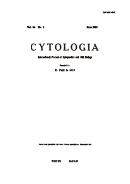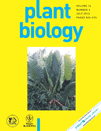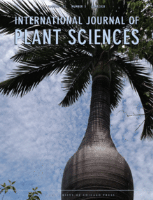
Propagation of Ornamental Plants
Scope & Guideline
Advancing Techniques for Sustainable Plant Propagation
Introduction
Aims and Scopes
- In Vitro Propagation Techniques:
A core focus of the journal is on the development and optimization of in vitro propagation methods, including micropropagation and somatic embryogenesis, which are essential for the rapid and efficient production of ornamental plants. - Plant Growth Regulators:
Research frequently explores the effects of various plant growth regulators (PGRs) such as auxins, cytokinins, and brassinosteroids on plant development, rooting, and shoot proliferation, contributing to improved propagation protocols. - Conservation and Genetic Studies:
The journal addresses the conservation of threatened ornamental species through in vitro techniques, as well as studies on genetic variation and morphogenesis, which are vital for maintaining biodiversity. - Lighting and Environmental Conditions:
Investigations into the impact of different lighting conditions, such as LED lighting, on plant growth and propagation success are featured prominently, reflecting the journal's commitment to optimizing growth environments. - Physiological Mechanisms:
The journal delves into the physiological mechanisms underlying plant responses to various treatments, enhancing the understanding of plant biology and improving propagation practices.
Trending and Emerging
- Use of Biostimulants and Natural Compounds:
There is a growing interest in the application of biostimulants, including seaweed extracts and other natural compounds, to enhance rooting and growth in various species, indicating a trend towards more sustainable and eco-friendly propagation practices. - Advanced Cryopreservation Techniques:
Research into cryopreservation methods for the long-term storage of plant genetic material is emerging as a significant theme, reflecting an increased focus on conservation and the preservation of genetic diversity. - Impact of Environmental Factors on Propagation:
Studies examining the influence of environmental factors, such as light quality and temperature, on propagation success are becoming more prominent, emphasizing the importance of optimizing growth conditions for ornamental plants. - Micropropagation Innovations:
Innovative approaches to micropropagation, including the use of novel substrates and growth conditions, are trending, as researchers seek to improve efficiency and reduce costs in the production of ornamental plants. - Assessment of Genetic Variation:
The use of molecular techniques to assess genetic variation among propagated plant populations is gaining traction, highlighting the importance of genetic studies in enhancing propagation success and plant quality.
Declining or Waning
- Traditional Propagation Methods:
There has been a noticeable decline in research focused on traditional propagation techniques, such as seed propagation and cuttings, as more emphasis is placed on advanced in vitro methods. - Natural Plant Interactions:
Studies exploring natural interactions between plants and their environments, such as symbiotic relationships and ecological propagation strategies, appear to be waning, possibly due to the increasing interest in controlled propagation environments. - Low-Tech Propagation Strategies:
Research involving low-tech or non-scientific propagation methods has diminished, as the journal increasingly emphasizes high-tech solutions and scientific approaches to plant propagation.
Similar Journals

RUSSIAN JOURNAL OF PLANT PHYSIOLOGY
Unveiling the Complexities of Plant InteractionsRUSSIAN JOURNAL OF PLANT PHYSIOLOGY, an esteemed publication with ISSN 1021-4437 and E-ISSN 1608-3407, is dedicated to advancing knowledge in the field of plant science. Published by PLEIADES PUBLISHING INC in the United States, this journal serves as a critical platform for researchers, professionals, and students aiming to explore the intricacies of plant physiology, biochemistry, and environmental interactions. With a consistent output from 1996 to 2024, the journal holds a commendable position within the academic community, reflected in its Q3 ranking among 516 journals in the Plant Science category (2023) and a competitive 44th percentile ranking in the Scopus database. Although the journal is not Open Access, it continues to attract a diverse readership of scholars eager to publish groundbreaking research. It stands out as a vital resource for anyone engaged in understanding the physiological processes that underpin plant life, thereby contributing to global agricultural advancements and ecological sustainability.

CYTOLOGIA
Fostering Innovation in Biological ResearchCYTOLOGIA is a prominent academic journal published by University of Tokyo Cytologia, specializing in the fields of Animal Science, Plant Science, Cell Biology, and Genetics. With origins dating back to 1929, this journal has been at the forefront of cytological research and continues to contribute to advancements in both basic and applied sciences. As of 2023, it holds a respectable position in various Scopus categories, with a Q3 ranking in Animal Science and Zoology and Plant Science, alongside Q4 rankings in Genetics and Cell Biology, reflecting its dedication to quality research dissemination. While currently not an Open Access journal, CYTOLOGIA provides critical insights and findings that are pivotal for researchers, professionals, and students aiming to further their understanding of cytology and its applications in diverse biological fields. With a historical legacy and ongoing relevance, CYTOLOGIA remains a vital resource for anyone engaged in cutting-edge research or seeking comprehensive knowledge in the biological sciences.

PLANT BIOLOGY
Connecting Researchers in Plant BiologyPLANT BIOLOGY is a prestigious academic journal published by Wiley, dedicated to advancing knowledge in the fields of plant science, ecology, and evolutionary biology. With an impressive impact factor and ranking in the Q1 category for Ecology, Evolution, Behavior and Systematics, and Plant Science as of 2023, it stands at the forefront of research dissemination. The journal encompasses a broad scope of plant biology topics, providing a critical platform for researchers to share innovative findings and foster interdisciplinary collaboration. Available in both print (ISSN: 1435-8603) and online formats (E-ISSN: 1438-8677), it ensures accessibility through open access options. As a crucial resource for professionals, researchers, and students alike, PLANT BIOLOGY cultivates a deeper understanding of plant systems and their ecological significance, making it an essential addition to the library of anyone dedicated to the study of biology and the environment.

Acta Scientiarum Polonorum-Hortorum Cultus
Fostering Collaboration in Agricultural Sciences.Acta Scientiarum Polonorum-Hortorum Cultus is a notable open-access journal dedicated to the field of horticultural science, published by UNIV LIFE SCIENCES LUBLIN in Poland. Since its inception in 2002, it has aimed to disseminate high-quality research findings, innovative methodologies, and advancements in the horticultural sector. The journal is indexed in Scopus and has ranked in the 33rd percentile for Horticulture and the 25th percentile for Plant Science, indicating its growing influence and relevance within the scientific community. Despite the challenges presented in quartile categorizations, Acta Scientiarum Polonorum maintains a commitment to cultivating knowledge and fostering collaboration among researchers, professionals, and students in the agricultural and biological sciences. With its publication timelines spanning from 2008 to 2024, the journal serves as a vital resource for those interested in the latest horticultural trends, sustainable practices, and scientific inquiries that drive the field forward.

Light & Engineering
Advancing Innovations in Light and TechnologyLight & Engineering is a prominent academic journal dedicated to the field of electrical and electronic engineering, published by ZNACK PUBLISHING HOUSE in the Russian Federation. Since its inception in 2008, the journal has been a valuable resource for researchers, professionals, and students seeking to advance their understanding of innovative technologies and methodologies in light engineering. With an HIndex that reflects the journal's contribution to the field, it holds a respectable Q3 classification in the 2023 category for Electrical and Electronic Engineering within Scopus rankings, indicating a growing influence and visibility. While currently not available as open access, the journal's content spans a range of pertinent topics that drive technological progress and scientific inquiry. Operating from PO BOX 648, 10100 MOSCOW, RUSSIA, it continuously strives to disseminate impactful research and foster collaborations within the scientific community. As the journal looks toward 2024, it remains committed to highlighting the critical intersections of light and engineering, making it an essential publication for anyone invested in these evolving fields.

INTERNATIONAL JOURNAL OF PLANT SCIENCES
Fostering interdisciplinary dialogue in plant research.The INTERNATIONAL JOURNAL OF PLANT SCIENCES, published by UNIV CHICAGO PRESS, is a leading journal dedicated to advancing knowledge in the fields of plant sciences and ecology. With an ISSN of 1058-5893 and an E-ISSN of 1537-5315, this journal has been a prominent platform for groundbreaking research since its establishment, featuring works from 1983 to present. It holds an impressive Q2 ranking in both Ecology, Evolution, Behavior and Systematics and Plant Science, reflecting its reputable standing within the academic community. The journal is well-regarded for its rigorous peer-review process and commitment to high-quality publication standards, making it a favored choice for researchers, students, and professionals eager to engage with the latest findings and innovative methodologies in plant research. While it does not currently operate under an Open Access model, the journal provides ample access options for institutions and individuals keen to explore its curated content. By presenting diverse studies that blend theoretical and practical insights, the INTERNATIONAL JOURNAL OF PLANT SCIENCES plays a critical role in fostering interdisciplinary dialogue and advancing the frontiers of plant science research.

Bangladesh Journal of Plant Taxonomy
Fostering knowledge, preserving biodiversity.Welcome to the Bangladesh Journal of Plant Taxonomy, a leading open-access publication dedicated to advancing the understanding of plant taxonomy in the context of Bangladesh's rich biodiversity. Published by the Bangladesh Association of Plant Taxonomists, this journal plays a crucial role in fostering academic discourse and dissemination of research findings since its establishment. With its ISSN 1028-2092 and E-ISSN 2224-7297, the journal provides a platform for researchers, professionals, and students to share their contributions to plant science. Although it has discontinued its coverage in Scopus from 2018, it remains a valuable resource, evidenced by its rankings in the agricultural and biological sciences categories, including a placement of #330/403 in Plant Science and #515/588 in Ecology, Evolution, Behavior, and Systematics. Open access since 2005, the journal ensures that critical research is freely available to all, supporting the global community in the study and preservation of plant biodiversity.

BANGLADESH JOURNAL OF BOTANY
Connecting Ecology and Conservation in BotanyBANGLADESH JOURNAL OF BOTANY is a prominent publication in the field of plant sciences, dedicated to advancing research and knowledge within the botanical community. Published by the BANGLADESH BOTANICAL SOC, this journal serves as a vital platform for researchers and scholars seeking to disseminate their findings related to plant biology, ecology, and conservation practices, particularly within the unique context of Bangladesh's diverse flora. With an ISSN of 0253-5416 and an E-ISSN of 2079-9926, the journal encompasses a wide scope of topics, reflecting interdisciplinary approaches in botanical research. Since its inception, with convergence periods from 1996 to 2001 and from 2003 to 2024, it has garnered recognition, positioned in the Q4 category in the Plant Science field with a ranking of #459/516 in Scopus, indicating its contribution to the field despite its developing impact. Operating within Bangladesh, at the UNIV DACCA DEPT BOTANY, the journal provides a crucial insight into the ecological and agricultural implications of plant studies in the region, catering to the needs of academics, professionals, and students eager to engage with contemporary botanical research.

Scientific Papers-Series B-Horticulture
Nurturing Ideas, Harvesting Solutions in Horticulture.Scientific Papers-Series B-Horticulture is a distinguished open-access journal published by the University of Agronomic Sciences and Veterinary Medicine Bucharest. With its ISSN 2285-5653 and E-ISSN 2286-1580, this journal has been accessible to the global research community since 2002, ensuring that vital horticultural research reaches a wide audience without barriers. Positioned at the forefront of the horticultural sciences, the journal serves as a platform for original research, reviews, and innovations pertaining to horticultural practices, plant physiology, and sustainable agriculture. Its contributions are not just significant in Romania but also resonate through the international scientific community, helping to address pressing agricultural challenges. The office located at 59 Marasti Boulevard, District 1, Bucharest 011464, Romania, symbolizes its commitment to advancing horticultural knowledge and fostering collaboration among researchers, professionals, and students alike. With no current H-index data, the journal invites continued contributions to enhance its visibility and impact in the field.

Botanical Studies
Promoting Accessible Knowledge in Plant StudiesBotanical Studies is a premier open-access journal published by Springer, dedicated to the field of botany and plant sciences. Since its establishment in 2006, the journal has championed innovative research and scholarship that explores diverse botanical topics ranging from plant systematics to ecology and conservation. With a commitment to broad accessibility, it promotes the dissemination of knowledge to researchers, professionals, and students worldwide. Botanical Studies fosters academic collaboration and dialogue, contributing significantly to the global botanical community. Its open-access policy allows unrestricted access to its high-quality, peer-reviewed content, ensuring that vital research is available to all. Join the growing community of scholars advancing botanical science through this essential publication, conveniently located at One New York Plaza, Suite 4600, New York, NY 10004, United States.